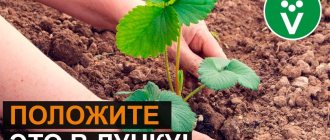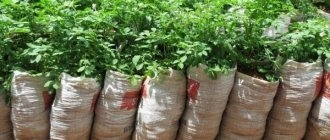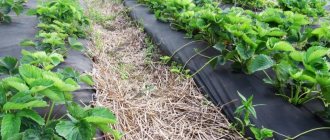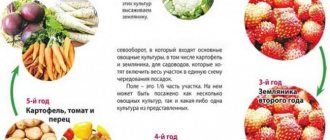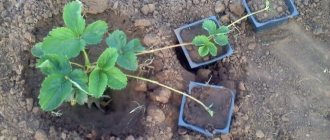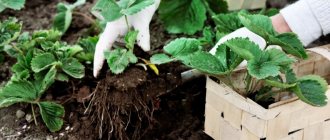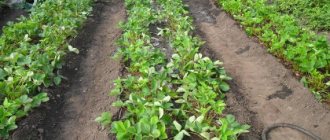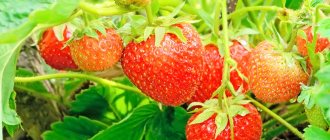Every summer resident wants the most productive strawberry bushes to grow and produce more and more berries.
One of the main methods of propagation of strawberries is propagation by mustaches. Dear readers!
For you, we have created communities on social networks in which useful articles and interesting ideas are published several times a day! Subscribe and receive useful content in a convenient format! In this article we will look at this method in detail. Let's look at its varieties and discuss the advantages and disadvantages.
Benefits of propagating strawberries with mustaches
This method of propagating strawberries has many advantages. Let's list the main ones.
- You can decide for yourself which bushes you will propagate. You can take the most productive ones or those with the most delicious berries;
- There is no need to struggle with seedlings, sowing seeds and transplanting seedlings;
- No containers for seedlings are needed;
- There is no need for an additional greenhouse or greenhouse;
- You don't need to buy new seedlings;
- The best characteristics of a particular strawberry variety can be preserved;
- The rosettes quickly take root and grow well.
The advantages of such reproduction
This method has only positive aspects. For example, when growing from seeds, a lot of effort and time is spent on complex care at first. You need a separate room, containers for sowing, special soil, then replanting and growing.
Knowing how to propagate strawberries with a mustache, the gardener only benefits.
Judge for yourself:
- The characteristics of the variety are fully preserved;
- All shoots take root;
- If you want to get a specific variety, propagate strawberries this way.
What kind of strawberry mustache is taken for reproduction?
Rosettes of the first order (first line), that is, those closest to the mother bush, are suitable for propagation. They must be healthy and show no signs of infection or disease.
After you have decided on the rosettes suitable for propagation, the mustache must be trimmed so that the rosettes of the next order do not take away nutrients.
The second important nuance when choosing a mustache is that bushes no older than 2 years are chosen for propagation. Older ones will give poor offspring.
ON A NOTE. This is the general rule for selecting strawberry mustaches. Some summer residents generally leave only one of the strongest sockets. Others, on the contrary, use second-order sockets when there is a shortage of planting material.
Landing rules
Planting is carried out on a dry, warm day. It is advisable for the weather to remain this way for several days before and after planting. When planting during hot weather, the leaves will begin to dry out. If the cuttings were grown in soil, they are cut off from the whiskers. When grown in peat cups, the mustache is also cut off, the cups are dug up and replanted with them.
How to plant layering step by step:
- Dig up the soil several weeks before the intended planting.
- Mix with rotted manure.
- Remove weeds.
- Make holes 20 cm deep and 25 cm wide.
- The distance between the holes is left up to 35 cm.
- Leave a distance of up to 65 cm between the rows.
- The seedling is dug up along with part of the soil.
- Place the seedling in the hole and cover it with soil.
- Lightly compact the soil.
At the end of planting, water the holes abundantly with water. Only warm water is used for irrigation. Watering with cold water promotes the development of fungal diseases. It is recommended to plant strawberries only in fertile soil.
How to determine a suitable landing site
For strawberries, areas that are well lit and warmed by the sun are suitable. In the shade, the berries turn out small and tasteless. It is ideal if the strawberry beds are protected on the north side by bushes or buildings.
The crop should not be planted after peppers, tomatoes, potatoes, zucchini, pumpkins, cucumbers, eggplants, roses and lilies. Good predecessors for strawberries are root vegetables, herbs, garlic, and onions.
It is also worth noting that the crop is demanding of moisture, but does not really like it when groundwater lies too close to the surface.
How to properly transplant strawberry mustaches
Mustache transplantation should be carried out in late spring - early summer or late summer - early autumn. Each term has its advantages and disadvantages.
You need to choose healthy, productive plants for replanting. There is no need to grow berries and let the bushes grow mustache at the same time. The bush simply won’t handle all the functions at once.
There is no need to rush with the transfer. After the appearance of the mustache, they are given another 1.5-2 months to grow and gain strength, and only then are separated from the uterine bush.
Transplantation must be carried out carefully and on a previously prepared area. After planting, the rooted rosettes need to be looked after so that they are well prepared for wintering and fruiting in the next season.
Choosing the right mother bush
So, even a season before you plan to separate cuttings from a strawberry bush, you can mark it by separating it from the total mass. Inspect it, take a closer look at those rosettes from which most of the largest and identical-sized berries (and, of course, tasty ones) were obtained. If everything is so, then why not tie a scarlet ribbon to this bush or stick a peg with the same ribbon next to it?
In addition, many gardeners try to kill two birds with one stone, they buy expensive strawberry seedlings and try with all their might to get both berries and mustaches from them (allowing literally all the mustaches to grow, because this is a precious planting material, they believe), which very often leads to trivial severe depletion of the bush and its long recovery.
But in order to collect strawberries and grow a normal, and not an insane amount of mustache, you need to wait only a year, allowing the mother bushes to bear fruit normally. All you have to do is postpone the breeding season to next year, but during this time, observing the bushes, you can easily identify those rosettes that will give the maximum yield.
Next year, leave just a couple of tendrils on the plant, maybe three, and mercilessly remove the rest, however, like the flower stalks, this will allow the plant to redirect all its energy specifically to the formation of seedlings, and fully developed ones at that.
The right choice of mother bush is the key to healthy strawberry seedlings.
How to propagate strawberries with a mustache step by step
Let's analyze the algorithm for propagating strawberries with a mustache in more detail:
- Identify the uterine whiskers and select the whiskers to be used for the procedure.
- When the rosettes on the tendrils begin to sprout roots, they are pinned to the ground and lightly sprinkled with soil or humus.
- Water the rosette every 3 days. Your task is to keep the soil slightly moist. If it rains, loosen the soil around it.
- A couple of days before transplanting, sprinkle the future strawberry planting site with sifted sand and loosen the soil.
- After a week or a week and a half, the rosettes can be seated. Rosettes must be healthy and developed, have at least 2 pairs of leaves. Ideally, the rosette should already be rooted and have roots about 5-7 cm long.
- Cut off the mustache 8-10 cm from the mother bush and carefully move it along with a lump of earth to a new place. Also, if space allows, the tendrils can simply be rooted in place by cutting them off from the mother bush.
- The depth of the grooves or planting holes is 2.5 cm. Planting should be done in increments of 30 cm between bushes and 50 cm between rows.
- Build a shelter for the transplanted rosettes from white agrofibre.
IMPORTANT! The procedure is carried out on a dry, fine day, but before lunch or after sunset.
How to propagate with mustaches in spring
Some summer residents consider spring-summer propagation preferable, since in this case the seedlings completely go through the adaptation period and are ready for wintering. Their point of view is based on the fact that the tendrils that strawberries produce in May and June are best suited for reproduction. The highest quality rosettes are formed on them, and buds are also laid for future fruiting.
Propagation by strawberry tendrils in autumn
However, traditionally the optimal time for mustache transplantation is from mid-July to mid-September, depending on the growing region.
Over the next 10 weeks before the onset of cold weather, the young bush fully adapts to independent life, forms a fully developed root system and lays buds for flowering next year.
IMPORTANT! When the rosettes are separated in late autumn, the bushes take root poorly, overwinter hard and bear full fruit only in the third year of growth.
Features of care
In order for the whiskers to take root in the new territory as quickly as possible, the garden bed needs to be watered frequently and the soil around the plants must be loosened. This is necessary to ensure that a crust does not form on the surface, which negatively affects the air permeability of the soil. Straw and sawdust are used for mulching. Avoid exposing the roots and paws, which are also involved in the formation of the plant’s root system. Therefore, watch this process and do not bury the core. If you first planted the seedlings in a pot, then after 2 weeks they can be planted in open ground. Sometimes strawberries in the garden reproduce chaotically. After flowering and fruiting, it sheds its mustache. Therefore, it is not necessary to cut them off immediately, but you can form a whole area of new plants, which will be located chaotically throughout the surrounding space. Strawberries love to fill large areas. However, this method of reproduction has both positive and negative sides. If we talk about the advantages of this method of propagating strawberries, we can note that you will not need to make much effort to form new plantings. All you need to take care of is to weed the area around the perimeter in a timely manner. Namely, the places where the strawberries will begin to cast mustaches. They must cling to clean soil. You will also need to water the rosettes in a timely manner and loosen the soil around them to make it easier for the root system to penetrate into the deeper layers of the soil. However, the disadvantage of this method of propagating strawberries is the following: it will simply be inconvenient for you to pick berries in the future, and the plants will grow too close to each other. Therefore, over time, the strawberries will become smaller, since all the bushes will not have enough nutrients. However, you can thin out the plantings. Thus, you can protect your site from these undesirable consequences. By the way, it is also inconvenient to weed and water plants in chaotically located plantings. In general, it can be noted that strawberries are not a very fastidious plant. It does not need to be constantly watered and hilled, but you will still have to pay attention to its care. If we talk about strawberry propagation methods, then separating stepchildren is the most effective way to instantly increase the number of new plantings on your site. However, all this must be done in a timely manner and according to certain rules. And, nevertheless, it is best to plant the stepsons in the beds, without allowing the strawberries to freely take over the surrounding space, this will make it easier for you to care for them and harvest them. Keep a close eye on the development of your strawberries and remember, propagation by runners is a great way to produce many new strong and healthy young plants.
Strawberry propagation by mustache
What is pot rooting
Some gardeners use the so-called “pot rooting method” when carrying out the strawberry propagation procedure. Its essence is that the selected outlet is placed in a small seedling pot (plastic cup). In this case, the rosette remains connected to the mother bush.
Next, the new bush takes root in its container and grows its root system. Then it is separated from the mother bush and transplanted to a new location.
This is the advantage of “pot rooting”. After all, the roots of the rosette are not damaged during transplantation. You simply take a ball of earth entwined with roots out of the cup and root it in a new place.
What can you plant after strawberries?
Garden strawberries not only taste good, but are also healthy. It contains pectic and nitrous acids and fiber. To cover the body's daily need for vitamin C, you need to eat 80 g of berries. It becomes so nutritious thanks to its highly branched root system. Through it, strawberries take away useful substances from the top layer of the earth, thereby depleting it. Garden strawberries are loved not only by humans, but also by various harmful microorganisms. Diseases and pests are also dangerous for the entire Rosaceae family: rose hips, raspberries, rowan.
After harvesting the berry bushes, it is better to let the soil rest and recover. For these purposes, green manure is planted. This is the name of green fertilizers grown to improve the texture of the soil, enrich it with nitrogen, proteins and get rid of weeds. Such fertilizers include:
- cereals,
- mustard,
- alfalfa and rapeseed.
Greenery will also help repel slugs. Umbrella root vegetable - carrots do not have the same pests as garden strawberries. In addition, its roots are fed from the lower layers of soil, not affected by the berry. Vegetable growers use this knowledge and obtain high yields of root crops by growing them after garden strawberries. You can also plant pumpkin plants in the vacant bed:
- cucumber,
- melon,
- pumpkin
It is still better to pre-prepare the soil for these vegetables by adding fertilizer.
Sunflower grown after berry bushes will not only produce a rich harvest of seeds, but will also attract small birds that will help exterminate harmful insects. After garden strawberries, the soil is poor in nitrogen content. Legumes restore it:
- peas,
- beans,
- soybean,
- peanut.
Their roots contain bacteria that fix nitrogen from the air and produce nitrogen-containing compounds. In agronomy, legumes are the main plants for restoring lands that have lost fertility.
If the space allows, you can make a flower bed in the garden. Peonies, tulips, lilies, petunias are good followers of the Rosaceae family. Gardeners also plant night violet; it is not only beautiful, but also emits a pleasant smell.
How to propagate the Norwegian way
To make strawberry rosettes easier to transplant, they can be planted in the Norwegian style. These are raised beds that are surrounded by boards. In this case, the plantings are covered with a film, which provides protection from atmospheric influences (rain, hail, wind and sun).
Norwegian beds are a really effective method in which the mustache takes root well. But there is a nuance. Inside the shelter, you need to constantly maintain suitable conditions for the growth and development of bushes: moisten the soil and loosen it, weed, and apply fertilizer. To do this, you will have to constantly remove and re-stretch the agricultural material that covers the strawberries.
How to care for a transplanted mustache
After you have transplanted, the seedlings will need to be cared for until the very end of the season. There is nothing complicated in this procedure, but it will require some attention.
The transplanted mustache must be covered with transparent agrofibre. This way you will protect the bushes from atmospheric influences: rain and sun.
Strawberries will have to be watered regularly, loosened and mulched. It is very important not to allow the soil under the berries to dry out. And mulch will protect the plantings from the growth of weeds.
After about 25-30 days, the transplanted mustache will need to be fed. It is best to use a comprehensive liquid berry fertilizer. You can buy any fertilizer from trusted manufacturers Agricola, Green Belt, etc. After feeding, the bushes need to be hilled up to stimulate root formation. The procedure must be performed carefully so as not to damage the roots.
The last stage of caring for transplanted rosettes is preparation for winter. The bushes are insulated with pine litter. This is the best material for covering strawberries. If you don't have pine needles on hand, use hay or straw.
ON A NOTE. If you did replant in the fall, then most likely you will not have to water the strawberries due to the rains that have begun. In any case, be guided by the condition of the soil.
Caring for strawberry seedlings
In order to prevent strawberry seedlings from dying - by the way, it is more correct to call them garden strawberries - you must follow certain rules. The first step is to prepare the bed. A lighted place, sheltered from the wind, is chosen for it. How strawberries grow depends on the crops that grew in the garden before this time. After nightshade crops or legumes, seedlings develop fastest.
Young bushes that were planted in the spring will begin to bloom and produce tendrils. This must be avoided - both the mustache and the color are sure to break off, otherwise the seedlings will wither before they have time to grow. In summer, this rarely happens, but it is still recommended to control the growth process. If you plant seedlings in the fall, tendrils and buds will not appear on the bushes.
Another rule for caring for young strawberries is to mulch them. This is done as follows - the ground around the bushes is covered with sawdust, dry hay, or pine needles. For successful cultivation, this procedure is important, since the soil, and with it the roots of the plant, dries out less. And if needles were used, then it also protects the plant from diseases and insects.
Even after propagation, strawberry bushes should be fertilized. Only organic matter is used as fertilizer, and this fertilizing is carried out when the strawberries have already taken root, that is, half a month after they were planted. The fertilizer is a liquid organic infusion that is carefully poured under the roots of the plant. Mineral fertilizers are not suitable here, as they burn the root system of young bushes. Here's what gardeners say about this:
“Like any other seedlings, strawberry bushes need to be fertilized. But, as with any other seedlings, it cannot be done without careful handling. No strong mineral fertilizers, either before or after planting. Only a soft organic solution. Chicken droppings and plant humus are suitable here. All this smells unpleasant, but the strawberries will grow.”
Why don't strawberries bloom, but produce mustaches?
There are several reasons for this problem:
Firstly , this is the degeneration of culture. Unfortunately, strawberries actively bear fruit only in the first 3-4 years. If more, then this is a happy coincidence and an exception to the rule.
Secondly , some varieties are genetically predisposed to the massive formation of new shoots.
Thirdly , strawberries may not bloom if the root collar is too deep.
Fourthly , the plant can be fed with nitrogen. In this case, it is necessary to replant and fertilize with nitrogen-potassium fertilizers.
Fifthly , it may be due to the wrong time of planting the berries and lack of lighting.
Which mustaches should not be used for reproduction?
The tendrils of those bushes that have already produced berries are not suitable for propagation. The rosettes will develop poorly, because the bush spent most of its energy on forming berries.
ON A NOTE. Thus, you need to immediately decide which bushes you will keep for berries, and which ones you will use for propagation.
Also, this method is not suitable for remontant varieties that are reluctant to produce aerial shoots.
If we talk about rosettes of 2-3 and subsequent orders, then they can be used for reproduction. But you need to understand that the harvest from them will be meager.
When will the mustache appear?
Strawberries of any variety are sure to produce mustaches. And more than once during the summer. Today we will talk about when to trim the mustache of strawberries. It should be borne in mind that if seedlings are required for propagation, then you should not remove the whiskers, you need to give them the opportunity to take root and grow a strong rosette. However, if you do not need seedlings, then be sure to remove them regularly, otherwise you risk your harvest.
Usually in the spring the plant produces only a few tendrils, so the summer resident can decide at his own discretion whether to trim them now or wait until they appear en masse in order to trim them all at once. This most massive release of whiskers occurs at the end of fruiting. However, we must remember that a bush burdened with many powerful shoots will not be able to produce the required number of berries, or they will be much smaller than they could be.
Common mistakes
- An attempt to propagate remontant strawberries in this way. Propagation by mustache is not suitable for these varieties of culture.
- Using all available sockets. Only the first ones are suitable for propagation, counting from the mother bush. The rest will produce small and tasteless berries.
- The mustache was trimmed at the wrong time . The ideal time to separate a new rosette from the mother bush is July.
- Repeated transplantation. Strawberries do not like to change where they grow. Therefore, immediately decide where you will transplant the new sockets.
- The growth of the mustache is not limited. The longer the mustache and the more rosettes on it, the smaller and worse they take root.
- The soil is not prepared properly. Strawberries love loose neutral soils. On other soils it takes root with difficulty.
- Excess organic fertilizers. Organic matter can be added when preparing the beds, but after replanting it is better to use ready-made complex fertilizers for berries.
Basic principles of whisker transplantation
Strawberries are transplanted with mustaches in spring and autumn. In some cases, you can plant berries in the summer. To grow mustaches, it is recommended to select several mother bushes at once. Such bushes will bear less fruit, but in the fall they will grow many mustaches with children.
You can plant mustaches without roots, when they have just begun to appear. True, such seedlings will grow longer. Only healthy bushes are suitable for planting. The leaves should not have white or red spots, holes or traces of insects. Only female bushes are used to grow mustaches. The female rosette can be distinguished by the presence of a peduncle and berries. In addition, female bushes produce mustaches several days later than male ones.

